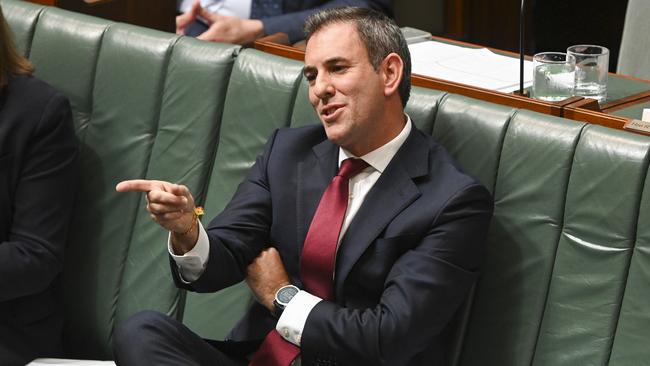Treasurer Jim Chalmers warns growth to slow, pressures to continue, reform to keep pace
Treasurer Jim Chalmers has warned the global economy faces its weakest point in decades, while also announcing a new financial reporting body.

Treasurer Jim Chalmers has acknowledged the economic recovery is placing pressure on Australians, but flagged the government would push forward with more economic reforms — including a new oversight structure for the financial sector.
Speaking at the Australian Securities and Investments Commission annual forum on Tuesday, Dr Chalmers said Australia’s economy was holding up alongside the broader global economic outlook.
But the Treasurer said expectations were that the economy would slow, something that was not unwelcome to some people given red hot inflation that has ramped up costs for consumers and businesses.
Dr Chalmers said people were “more or less welcoming” of expectations of a slowdown, with projections the global economy was facing its weakest point in decades.
The Treasurer said it was a “sign of the times” that there was considerable uncertainty, but he said there would still be growth.
“We would like (inflation) to moderate further and faster,” he said. “(The) labour market is remarkably resilient.”
But Dr Chalmers noted the pressures from Australia’s migration wave, which has added more than 500,000 additional people to the economy over the past year.
Meanwhile, the Treasurer said the services sector was helping to support the economy, making a “big contribution to growth”, which was partly driven by migration.
But tourism and education often went missing in discussions about the country, he noted.
Dr Chalmers said the labour market was showing its “quite remarkable” strength, with migration levels recovering “quite quickly” from pandemic levels.
“That’s helping when it comes to services exports,” he said.
“But it’s putting pressures obviously on communities as well, but we are conscious of that.” The government was trying to manage medium term pressures in the economy, he said, noting the massive turnaround in the budget was not expected to last, with the budget to sit in deficit in coming years.
But Dr Chalmers said budget pressures were intensifying rather than easing, with the government’s move to slash infrastructure projects an acknowledgment of blowouts in spending.
The Treasurer said the government had to determine “how we can actually build the projects that have been committed” in a more efficient way.
He said $40bn in savings have been identified in two budgets.
Further, Dr Chalmers said the government had a three-pronged approach to managing inflation. That included budget repair, $24bn in cost-of-living support and addressing supply side challenges.
Dr Chalmers said efforts from the government to cut spending and bank the recent surplus would see gross debt peak lower rather than higher.
The Treasurer said the federal government’s economic reform agenda was guided by three key pillars including making the economy more productive and dynamic, maintaining focus on people and place and taking a long-term view.
Dr Chalmers identified eight areas of the government’s economic strategy, including: budget repair, tackling inflation, achieving net zero targets, maximising human capital, broadening industrial the country’s base and investment and promoting efficient markets.
Areas of tax reform included looking at superannuation funds, the PRRT, multinational tax obligations and ensuring “compliance” to close the tax gap, Dr Chalmers said.
The Treasurer also revealed on Tuesday the government would create a new financial reporting body and introduce its first statement of expectations for ASIC since 2021, saying there was “more work to do” to reform Australia’s financial institutions.
He said the government would combine the three existing bodies that oversee financial reporting in Australia — the Australian Accounting Standards board, the Auditing and Assurance Standards Board, and Financial Reporting Council — in response to the PwC Australia scandal.
He said the new combined institution would be focused on introducing new climate reporting standards as well as lifting standards across the auditing sector.
The Treasurer said the government was taking this action after scandals surrounding PwC and hoped it would slash red tape.
Dr Chalmers also said the government would soon issue a new statement of expectations to ASIC, setting a list of priorities for the regulator to focus on.
The last time ASIC was issued a statement of expectations was in August 2021 by then-Treasurer Josh Frydenberg after the regulator’s new leadership under chair Joe Longo and deputy chair Sarah Court were put in place.
ASIC was then tasked with “supporting Australia’s economic recovery from the Covid-19 pandemic and work closely with Government and Treasury on the implementation of policy reforms and in its exercise of policy-related functions”.
Dr Chalmers said on Tuesday he would change ASIC’s focus to task the regulator with focusing on protecting consumers in the “digital sphere” and addressing the risks and capture the opportunities of the market’s transition to net zero.
At the same conference, ASIC chair Joe Longo said the regulator was preparing for a wave of new regulation, with cryptocurrency and artificial intelligence at the forefront.
Mr Longo said there was a “massive renegotiation” of the role of the state “in people’s lives” that was driving this regulatory intervention.
Meanwhile, “a lot of people are feeling left behind” he said, creating the need to “figure out what the policy and regulatory settings are that are going to deliver for a whole lot of people that feel that they’ve just been left behind”.
“I think regulation is going to be a constant feature of that,” he said.






